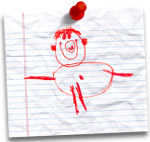Introduction
Salsa music has a complex rhythm. Understanding the rhythm can help you to find the 1-beat or find the 2-beat so that you know when to start dancing. On this page I introduce the most important salsa percussion instruments and explain their common rhythms. You can listen to each instrument as you read about it or combine them in the interactive rhythm player at the end.
Not necessarily all these instruments will be used in salsa music and even when they are, the rhythm that each instrument plays can vary throughout the music - some coming in during the chorus and others in the verse. Sometimes an instrument will play a variation on the basic rhythm presented here.
Clave
Clave (pronounced "clah-vay") is both a rhythm and an instrument. The "son clave" rhythm is the fundamental rhythm in salsa music and has two main variations: the "3-2 clave" shown below, and the "2-3 clave" which has the two bars in the reverse order. The choice of 2-3 or 3-2 depends on the music's melody. It may start or stop during the music but will not change from one form to the other in a single piece. The "3-2" variation is used in the player below.

Conga
The conga is a tall drum that is played with both hands. It may be played as part of a set of congas of different sizes. The basic salsa conga rhythm is called the "tumbaó" (demonstrated by Nate Torres in this video). It is quite complex, but the loudest notes are the ones to watch for: the "boom-boom" open tones that occur on beats 4 and 4½ and again on beats 8 and 8½, and the "slap" on beats 2 and 6. These accented notes are played by the "Conga (basic)" rhythm in the player below.
The full tumbaó rhythm can also be played ("complex"). The notation used is pairs of letters: "L" or "R" for left or right hand and then "H" for heel, "T" for toe or tip, "S" for slap and "O" for open.

Cow Bell
The cow bell (or "campana" or "bongo bell") is played by the bongo player during the louder parts of salsa music (the "montuno" or "mambo" sections). In the player below there is a basic rhythm which plays on just beats 1, 3, 5 and 7. These are the "strong" or "fundamental" beats of salsa. A more complex rhythm is also included in the player which adds some extra beats to the basic rhythm. The extra beats are different in the first and second bars and so give a clue about which bar is playing even when the clave has stopped.
Timbale
In the verses and softer sections of the music a rhythm is often played with a drum stick on the side of a drum such as the timbale or tom. This rhythm is called the "cáscara" rhythm (meaning "shell" as it is played on the shell of the timbale).

Güiro
This is the one that makes that scraping sound. Like the cow bell, the güiro accents the 1, 3, 5 and 7 fundamental beats of salsa with long notes. Between these long notes it plays two short notes.
Player
In this rhythm player you can listen to the main salsa percussion instruments together or one by one by clicking on the instrument names to turn them off and on. I've put a dark green square in the beats where an instrument plays loudly and a light green square in the beats where it plays softly. The lines in grey are not playing.
I've also shown the men's steps for three different styles of salsa: "LA", "New York" and "Palladium". The notation I have used is pairs of letters: first "L" or "R" for left or right foot, then "F", "S" or "B" for forward, on the spot or backward. I have also put a slash ("/") for when the break is, i.e when you change direction. For LA and Palladium start with your right foot in front of your left, but for New York style start with your left foot in front. There's no way you can learn to dance salsa from reading about it, but the steps are there to let you see how the steps and the percussion instruments interact.
| 1 | 2 | 3 | 4 | 5 | 6 | 7 | 8 | ||||||||||
| RS | RO | RO | RS | RO | RO | ||||||||||||
| LH | LT | RS | LT | LH | LT | RO | LT | LH | LT | RS | LT | RS | LT | RO | RO | ||
| LA (on 1) | LF / | RS | LB | RB / | LS | RF | |||||||||||
| New York (on 2) | LB | RB / | LS | RF | LF / | RS | |||||||||||
| Palladium (on 2) | LF / | RS | LB | RB / | LS | RF | |||||||||||
Notes
The audio functions on this page require JavaScript to be enabled. It is known to work well in the latest Chrome, Firefox, Safari and Edge web browsers, including mobile versions (which implement the Web Audio API and can be downloaded here). It cannot work in Internet Explorer.
